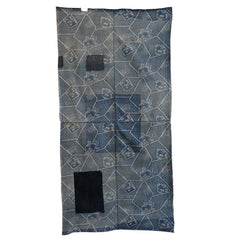A Patched and Pieced Large Narumi Kongata Cloth: Stencil Dyeing Mimicking Shibori
early twentieth century
51 1/4" x 26", 130.25 cm x 66 cm
This is a large area of pieced Narumi kongata cotton, the cloth is hand stitched from four separate fragments of cloth and it seems to be a section from a furoshiki or carrying cloth.
Narumi kongata is a kind of katazome dyeing that employs a set of stencils which, when resisted and dyed, creates an intentional shibori-like effect as is the case on this example here.
Soft edges give the impression of faux shibori are a standard feature in the repertoire of Narumi kongata and this length of complex patterned cotton shows this quality well.
The geometric, repeat pattern is probably based on a traditional design that alludes to cracking or thawing ice, a sign of spring. Elaborately designed small images are tucked into the diagonal lines of the overall pattern.
As is obvious there is strong, overall light fading to the piece with the exception of the square, center area which is darker in tone than the rest. Clearly this was a patched section of the cloth and the patch had been removed at some point in the lifetime of this cloth.
This slightly darkened center area plays off nicely against the applied patches that surround it. A notch is missing from the top, left area as is seen on the accompanying photos.
Because of the complexity of the dyeing process Narumi kongata is considered to be a desirable type of stencil resist dyeing and now--and certainly at the time of its making--it is more costly than standard types of stencil resist dyeing.
This is a rather generous area of Narumi kongata and one that bears so much interesting evidence from its life of service that it cannot help but draw you in to the tangible traces of its history.
Recommended.


